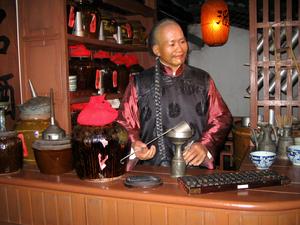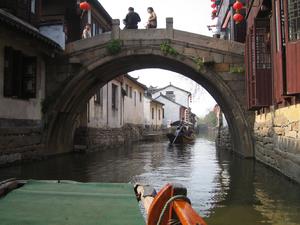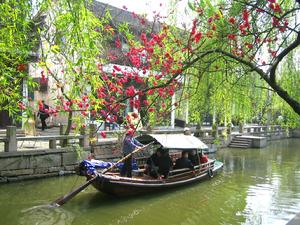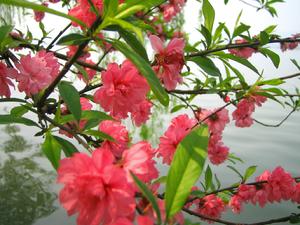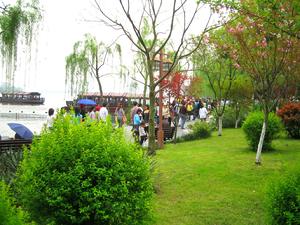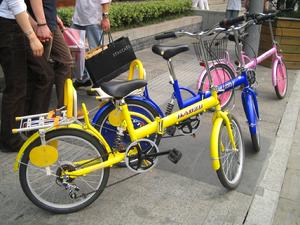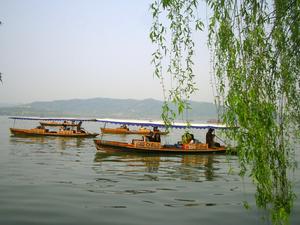jueves, 7 de julio de 2011
Shanghai In Pictures
Shanghai, the business center of China
| The two most photographed and recognized sites in Shanghai are the Oriental Pearl TV Tower and the Bund, and will not be featured here. Instead we will give you a little taste other things to see and do while in Shanghai. One is inside the Tower. It is a wax museum of the history of the culture of Shanghai and well worth checking out. The other is the Shanghai Aquarium next door to the Tower. While the admission is a little pricey (oh well, this is Shanghai) the exhibits are very well done and worth the visit for anyone interested in marine life and in particular the Asian marine environment. Another thing to do is Shanghai is not actually in the city. Shanghai is located on the delta of the Yangtze River and as such is surrounded by vast wetlands. For centuries, these wetlands have held Water Towns that made use of and adapted to the networks of waters created by the delta. One of the more preserved ones is Zhou Zhuang, located about 1 hour's drive from downtown. |
| Located 2 hours highway drive from Shanghai downtown is the city of Hangzhou. If you do not have a car, there are a multitude of tours you can join or just take the train (cheap, fast). Go to Hangzhou to relax and enjoy the scenerary along the shore of Xi Hu (west lake) during the day and the nightlife along the shore at night. |
China Great Wall
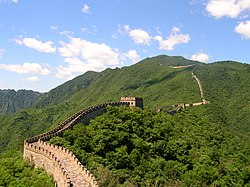
Known to the Chinese as the 'Long Wall of Ten Thousand Li', the formidable defensive structures built to ward off invasion of the Celestial Empire by barbarians is called the Great Wall or the Wall of China by Europeans. The principle of these extraordinary fortifications goes back to the Chunqiu period (722-481 BC) and to the Warring States period (453-221 BC).
The construction of certain walls can be explained by feudal conflicts, such as that built by the Wei in 408 BC to defend their kingdom against the Qin. Its vestiges, conserved in the centre of China, antedate by many years the walls built by the Kingdoms of Qin, Zhao and Yan against the northern barbarians around 300 BC. Beginning in 220 BC, Qin Shi Huang, the founder of the Empire of the Ten Thousand Generations, undertook to restore and link up the separate sections of the Great Wall which had been built in the 3rd century BC, or perhaps even earlier, and which stretched from the region of the Ordos to Manchuria.
Towards the west, he had extended the fortifications, the first cohesive defence system of which significant vestiges still remain in the valley of the Huanghe all the way to Lanzhou shortly before the accession of the Han dynasty (206 BC). During their reign the Great Wall was extended even further, and under the emperor Wudi (140-87 BC) it spanned approximately 6,000 km between Dunhuang in the west and the Bohai Sea in the east. The danger of incursion along the northern Chinese border by the federated Mongols, Turks and Tunguz of the Empire of the Xiongnu, the first empire of the steppes, made a defence policy more necessary than ever. After the downfall of the Han dynasty (AD 220), the Great Wall entered its medieval phase. Construction and maintenance works were halted; China at that time enjoyed such great military power that the need for a defence policy was no longer felt.
It was the Ming Emperors (1368-1644) who, after the long period of conflict that ended with the expulsion of the Mongols, revived the tradition begun by Qin Shi Huang. During the Ming dynasty, 5,650 km of wall were built. To defend the northern frontier, the Wall was divided into nine Zhen, military districts rather than garrisons. At strategic points, fortresses were built to defend the towns, passes, or fords. The passageways running along the top of the wall made it possible to move troops rapidly and for imperial couriers to travel. Two symbolic monuments still proudly stand at either end of the wall - the First Door under Heaven at Shanhaiguan, located at the wall's eastern end, and the Last Door under Heaven at Jiayuguan, which, as part of the fortress entirely restored after 1949, marks its north-western end.
This complex and diachronic cultural property is an outstanding and unique example of a military architectural ensemble which served a single strategic purpose for 2,000 years, but whose construction history illustrates successive advances in defence techniques and adaptation to changing political contexts. The purpose of The Great Wall was to protect China from outside aggression, but also to preserve its culture from the customs of foreign barbarians. Because its construction implied suffering, it is one of the essential references in Chinese literature.
The Great Wall of the Ming is, not only because of the ambitious character of the undertaking but also the perfection of its construction, a masterpiece. The wall constitutes, on the vast scale of a continent, a perfect example of architecture integrated into the landscape. During the Chunqiu period, the Chinese imposed their models of construction and organization of space in building the defence works along the northern frontier. The spread of Sinicism was accentuated by the population transfers necessitated by the Great Wall.
That the great walls bear exceptional testimony to the civilizations of ancient China is illustrated as much by the tamped-earth sections of fortifications dating from the Western Han that are conserved in Gansu Province as by the admirable and universally acclaimed masonry of the Ming period.
China Means Business - But What Kind of Business - Want to Learn More?
If you are in business for yourself or run a company, shouldn't you be reading more about China? After all it is now the second-largest economy in the world now, and it seems to be growing and it should keep on growing for quite a while. There are far too many people who are too willing to label China in a single sentence, and think they understand what China is all about - can you imagine trying to describe the USA in one-sentence? It is for this reason that I like to recommend a very good book that I think you should read, the name of the book is;
"China * INC - How the Rise of the Next Super Power Challenges America and the World," by Ted C. Fishman, Scribner Publishing, a Simon Schuster Company - MacMillian Licensed, New York, NY, 2005. (pp 342), ISBN: 0-743-5752-9.
This book is extremely eye-opening and very well written, the author writes for the New York Times Magazine, Money, Worth, USA Today, Business 2.0, and also was a trader at the Chicago Mercantile Exchange. His book takes us from Communist China to Capitalist Super Power, and talks about how it is expanding at roughly three-times the US growth rate, (approximately 10% year-over-year), and how 300 million peasant farmers left their work in agriculture to work in factories. This was the largest migration in human history from rural China to the Guangdong Province and other factory areas.
It is estimated that this cost 2.9 million jobs in manufacturing in the United States. Speaking of which I don't want to cut into Mr. Fishman's excellent book here, but I would like to recommend another very good reading;
Chinese Horoscopes

When I finally came apon this snowshoe hare to photograph I was so happy to see it had the perfect den in the hollow of this old stump. It just looked like so much like a story book cover that I totally loved the shot.
Photograph by Darrell Abolit, My Shot
Chinese tradition says a different animal represents each new year. Which is yours?
According to the Chinese calendar, the year you were born may determine your personality. Every year is represented by an animal, and legend has it that people born under that animal have certain personality traits. So just for fun, find your birth year and that year's animal, and see what some people believe it says about you. Do the same for your friends, parents, relatives, and teachers.
2011: The Year of the Rabbit
The Real Thing:
Rabbits normally give birth to about six babies at once and often live in groups. Their long ears help them cool off by lowering the temperature of the blood that circulates through them.
Born a Rabbit?
Well-liked and popular, you have a large circle of family and friends. You are very protective of them, and they protect you back. You tend to keep your cool and avoid conflicts.
Other Rabbit Years:
1927, 1939, 1951, 1963, 1975, 1987, 1999, 2011, 2023
Dragon
The Real Thing:
The mythical dragon is a symbol of power and good fortune in Chinese culture. One of the most popular figures in Chinese art, the dragon is believed to be a combination of nine animals, including a frog, a tiger, an eagle, and a fish.
Born a Dragon?
You go out of your way to help your friends, who often seek you out for advice. Your outgoing personality helps you get along with many types of people.
Other Dragon Years:
1928, 1940, 1952, 1964, 1976, 1988, 2000, 2012
Snake
The Real Thing:
Snakes have great instincts. Some "play dead" to fool predators, and most sense prey by detecting ground vibrations. They can take more than an hour to swallow a meal, and they become inactive for up to two weeks before they shed their skin.
Born a Snake?
You rely on your instincts before asking others their opinions. At times you want to take a break from the action. It's not that you're lazy—sometimes you just like to think.
Other Snake Years:
1929, 1941, 1953, 1965, 1977, 1989, 2001, 2013
Horse
The Real Thing:
A horse sleeps only about three hours a day. Intelligent, most can sense nervousness in people.
Born a Horse?
You have loads of energy and love adventure. You take charge and understand people, so you know how to work a crowd.
Other Horse Years:
1930, 1942, 1954, 1966, 1978, 1990, 2002, 2014
Sheep
The Real Thing:
Timid sheep graze in flocks to guard against predators. Most are raised for their wool.
At your best when people who admire you flock to your side, you stick by your friends. You are artistic, creative, and like to look good.
Other Sheep Years:
1931, 1943, 1955, 1967, 1979, 1991, 2003, 2015
Monkey
The Real Thing:
Social and playful, monkeys show affection and friendship by picking bugs and dirt out of each other's fur. These animals use their hands and feet to grip objects and climb trees. Some even have tails that can grab items as small as peanuts.
Born a Monkey?
Swinging from one group of friends to another, you love to have a good time. You like to entertain your friends by showing off your talents, and they appreciate your cleverness and sense of humor.
Other Monkey Years:
1932, 1944, 1956, 1968, 1980, 1992, 2004, 2016
Rooster
The Real Thing:
The rooster's loud cock-a-doodle-doo attracts females and warns other males to stay away. The red comb on his head may help other roosters identify him, and it also sets him apart from other bird species.
Born a Rooster?
You are practical and resourceful, and you use what you have to succeed without taking a lot of risks. A hard worker, you say what's on your mind and have a sense of style that sets you apart.
Other Rooster Years:
1933, 1945, 1957, 1969, 1981, 1993, 2005, 2017
Dog
The Real Thing:
A dog's supersensitive ears can hear a noise about 100 yards (91.44 meters) away that a person couldn't hear more than 25 yards (22.86 meters) away. Its strong sense of smell helps it do things like find lost people or sniff out bad guys.
Born a Dog?
You're a great listener who can keep a secret. Loyal to your friends, you have a keen sense of right and wrong and stick to what you believe in.
Other Dog Years:
1922, 1934, 1946, 1958, 1970, 1982, 1994, 2006, 2018
Pig
The Real Thing:
Domesticated pigs have been helping humans for about 9,000 years. Incredibly intelligent, a pig shows its smarts by rolling in mud and sticking its snout in dirt. Why? The mud keeps it cool, and rooting in the dirt provides important vitamins.
Born a Pig?
Smart and caring, you live to help other people. You have great taste and love to wallow in the nicer things in life.
Other Pig Years:
1923, 1935, 1947, 1959, 1971, 1983, 1995, 2007, 2019
Rats
The Real Thing:
Most rats are highly adaptable. They can live just about anywhere and eat just about anything. Before brown rats leave their underground burrows, these clever creatures send one rat ahead to make sure danger isn't lurking outside.
Born a Rat?
You welcome challenges and enjoy learning about new things. Funny and smart, you are generous and will protect your pack of friends.
Other Rat Years:
1924, 1936, 1948, 1960, 1972, 1984, 1996, 2008, 2020
Oxen
The Real Thing:
Oxen have been known to pull loads of 11,284 pounds (5,118 kilograms). People value their strength as well as their work ethic. An ox's horns can grow to be more than 20 inches (51 centimeters) long.
Born an Ox?
You approach projects in a step-by-step manner, wanting to do things right the first time. Shy but dependable, you are caring and trustworthy and never lose sight of your goal.
Other Ox Years:
According to the Chinese calendar, the year you were born may determine your personality. Every year is represented by an animal, and legend has it that people born under that animal have certain personality traits. So just for fun, find your birth year and that year's animal, and see what some people believe it says about you. Do the same for your friends, parents, relatives, and teachers.
2011: The Year of the Rabbit
The Real Thing:
Rabbits normally give birth to about six babies at once and often live in groups. Their long ears help them cool off by lowering the temperature of the blood that circulates through them.
Born a Rabbit?
Well-liked and popular, you have a large circle of family and friends. You are very protective of them, and they protect you back. You tend to keep your cool and avoid conflicts.
Other Rabbit Years:
1927, 1939, 1951, 1963, 1975, 1987, 1999, 2011, 2023
Dragon
The Real Thing:
The mythical dragon is a symbol of power and good fortune in Chinese culture. One of the most popular figures in Chinese art, the dragon is believed to be a combination of nine animals, including a frog, a tiger, an eagle, and a fish.
Born a Dragon?
You go out of your way to help your friends, who often seek you out for advice. Your outgoing personality helps you get along with many types of people.
Other Dragon Years:
1928, 1940, 1952, 1964, 1976, 1988, 2000, 2012
Snake
The Real Thing:
Snakes have great instincts. Some "play dead" to fool predators, and most sense prey by detecting ground vibrations. They can take more than an hour to swallow a meal, and they become inactive for up to two weeks before they shed their skin.
Born a Snake?
You rely on your instincts before asking others their opinions. At times you want to take a break from the action. It's not that you're lazy—sometimes you just like to think.
Other Snake Years:
1929, 1941, 1953, 1965, 1977, 1989, 2001, 2013
Horse
The Real Thing:
A horse sleeps only about three hours a day. Intelligent, most can sense nervousness in people.
Born a Horse?
You have loads of energy and love adventure. You take charge and understand people, so you know how to work a crowd.
Other Horse Years:
1930, 1942, 1954, 1966, 1978, 1990, 2002, 2014
Sheep
The Real Thing:
Timid sheep graze in flocks to guard against predators. Most are raised for their wool.
At your best when people who admire you flock to your side, you stick by your friends. You are artistic, creative, and like to look good.
Other Sheep Years:
1931, 1943, 1955, 1967, 1979, 1991, 2003, 2015
Monkey
The Real Thing:
Social and playful, monkeys show affection and friendship by picking bugs and dirt out of each other's fur. These animals use their hands and feet to grip objects and climb trees. Some even have tails that can grab items as small as peanuts.
Born a Monkey?
Swinging from one group of friends to another, you love to have a good time. You like to entertain your friends by showing off your talents, and they appreciate your cleverness and sense of humor.
Other Monkey Years:
1932, 1944, 1956, 1968, 1980, 1992, 2004, 2016
Rooster
The Real Thing:
The rooster's loud cock-a-doodle-doo attracts females and warns other males to stay away. The red comb on his head may help other roosters identify him, and it also sets him apart from other bird species.
Born a Rooster?
You are practical and resourceful, and you use what you have to succeed without taking a lot of risks. A hard worker, you say what's on your mind and have a sense of style that sets you apart.
Other Rooster Years:
1933, 1945, 1957, 1969, 1981, 1993, 2005, 2017
Dog
The Real Thing:
A dog's supersensitive ears can hear a noise about 100 yards (91.44 meters) away that a person couldn't hear more than 25 yards (22.86 meters) away. Its strong sense of smell helps it do things like find lost people or sniff out bad guys.
Born a Dog?
You're a great listener who can keep a secret. Loyal to your friends, you have a keen sense of right and wrong and stick to what you believe in.
Other Dog Years:
1922, 1934, 1946, 1958, 1970, 1982, 1994, 2006, 2018
Pig
The Real Thing:
Domesticated pigs have been helping humans for about 9,000 years. Incredibly intelligent, a pig shows its smarts by rolling in mud and sticking its snout in dirt. Why? The mud keeps it cool, and rooting in the dirt provides important vitamins.
Born a Pig?
Smart and caring, you live to help other people. You have great taste and love to wallow in the nicer things in life.
Other Pig Years:
1923, 1935, 1947, 1959, 1971, 1983, 1995, 2007, 2019
Rats
The Real Thing:
Most rats are highly adaptable. They can live just about anywhere and eat just about anything. Before brown rats leave their underground burrows, these clever creatures send one rat ahead to make sure danger isn't lurking outside.
Born a Rat?
You welcome challenges and enjoy learning about new things. Funny and smart, you are generous and will protect your pack of friends.
Other Rat Years:
1924, 1936, 1948, 1960, 1972, 1984, 1996, 2008, 2020
Oxen
The Real Thing:
Oxen have been known to pull loads of 11,284 pounds (5,118 kilograms). People value their strength as well as their work ethic. An ox's horns can grow to be more than 20 inches (51 centimeters) long.
Born an Ox?
You approach projects in a step-by-step manner, wanting to do things right the first time. Shy but dependable, you are caring and trustworthy and never lose sight of your goal.
Other Ox Years:
1925, 1937, 1949, 1961, 1973, 1985, 1997, 2009, 2021
Tiger
The Real Thing:
The largest of the big cats, tigers hunt alone. They secretly stalk prey, then leap and attack when the time seems right. Dinner still escapes most of the time.
Born a Tiger?
You're a natural leader but often like to do things by yourself. (That's how you stay in charge!) You believe in fighting for what's right, even if you'll lose in the end.
Tiger
The Real Thing:
The largest of the big cats, tigers hunt alone. They secretly stalk prey, then leap and attack when the time seems right. Dinner still escapes most of the time.
Born a Tiger?
You're a natural leader but often like to do things by yourself. (That's how you stay in charge!) You believe in fighting for what's right, even if you'll lose in the end.
Other Tiger Years:
1926, 1938, 1950, 1962, 1974, 1986, 1998, 2010, 2022
1926, 1938, 1950, 1962, 1974, 1986, 1998, 2010, 2022
miércoles, 6 de julio de 2011
A Brief History of the Chinese Martial Arts
The beginning of Chinese martial arts probably started long before history was recorded. Martial techniques were discovered or created during the long epoch of continuous conflict between humanity and animals, or between different tribes of humans themselves. From these battles, experiences were accumulated and techniques discovered which were passed down generation to generation.
Later, with the invention of weapons, different types and shapes of weapons were invented, until eventually metal was discovered. Following the advancement of weapon fabrication, new fighting techniques were created. Different schools and styles originated and tested one another.
Many of these schools or styles created their forms by imitating different types of fighting techniques from animals (tiger, panther, monkey, snake, or bear), birds (eagle, crane, or chicken), or insects (praying mantis). The reason for imitating the animals’ fighting was that it was believed that, in order to survive in the harsh natural environment, all the animals still maintained a natural talent and skill for fighting. The best way to learn the fighting techniques was by studying and imitating these animals. For example, the sharp spirit of the eagle was adopted, the pouncing/fighting of the tiger and eagle’s strong claws was imitated, and the attacking motions of the crane’s beak and wings were copied.
Since the martial techniques first developed in very ancient times, gradually they became part of Chinese culture. The philosophy of these fighting arts and culture has in turn been influenced by other elements of Chinese culture. Therefore, the Yin/Yang Taiji theory was adopted into the techniques, and the Bagua (Eight Trigrams) concept was blended into the fighting strategy and skills.
Buddhism traveled to China from Nepal/India during the Eastern Han Ming emperor period (58-76 A.D.). Several hundred years after this, as several emperors became sincere Buddhists, Buddhism became very respected and popular in China. It is estimated that by 500 A.D., there probably existed more than 10 thousand Buddhist temples. In order to absorb more Buddhist philosophy during these five hundred years, some monks were sent to India to study Buddhism and bring back Buddhist classics. Naturally, some Indian monks were also invited to China for preaching.
According to one of the oldest books Deng Feng County Recording (Deng Feng Xian Zhi), a Buddhist monk name Batuo came to China for Buddhist preaching in 464 A.D. Deng Feng was the county where the Shaolin Temple was eventually located.
Thirty-one years later, the Shaolin Temple was built in 495 A.D., by the order of Wei Xiao Wen emperor (471-500 A.D.) for Batuo’s preaching. Therefore, Batuo can be considered the first chief monk of the Shaolin Temple. However, there is no record regarding how and what Batuo passed down by way of religious Qigong practice. There is also no record of how or when Batuo died.
However, the most influential person in this area was the Indian monk Da Mo (Pu Ti Ta Mo). Da Mo, whose last name was Sardili and who was also known as Bodhidarma, was once the prince of a small tribe in southern India. He was of the Mahayana school of Buddhism, and was considered by many to have been a bodhisattva, or an enlightened being who had renounced nirvana in order to save others. He is considered the 28th patriarch of Buddhism from India, and the 1st patriarch of Buddhism in China. From the fragments of historical records, it is believed that he was born about 483 A.D.
Da Mo was invited to China to preach by the Liang Wu emperor. He arrived in Canton, China in 527 A.D. during the reign of the Wei Xiao Ming emperor(516-528 A.D.) or the Liang Wu emperor (502-550 A.D.). When the emperor decided he did not like Da Mo’s Buddhist theory, the monk withdrew to the Shaolin Temple. When Da Mo arrived, he saw that the priests were weak and sickly, so he shut himself away to ponder the problem. When he emerged after nine years of seclusion, he wrote two classics: Yi Jin Jing (Muscle/Tendon Changing Classic) and Xi Sui Jin (Marrow/Brain Washing Classic).
The Yi Jin Jing taught the priests how to build their Qi to an abundant level and use it to improve health and change their physical bodies from weak to strong. After the priests practiced the Yi Jin Jing exercises, they found that not only did they improve their health, but they also greatly increased their strength. When this training was integrated into the martial arts forms, it increased the effectiveness of their martial techniques. This change marked one more step in the growth of the Chinese martial arts: Martial Arts Qigong.
The Xi Sui Jing taught the priests how to use Qi to clean their bone marrow and strengthen their immune system, as well as how to nourish and energize the brain, helping them to attain Buddhahood. Because the Xi Sui Jing was hard to understand and practice, the training methods were passed down secretly to only a very few disciples in each generation. Da Mo died in the Shaolin Temple in 536 A.D. and was buried on Xiong Er mountain. If you are interested in knowing more about Yi Jin Jing and Xi Sui Jing, please refer to the YMAA book, “Qigong - The Secret of Youth: Muscle/Tendon Changing and Marrow/ Brain Washing”.
During the revolutionary period between the Sui dynasty and the Tang dynasty, in the 4th year of Tang Gao Zu Wu De (621 A.D., Qin King Li Shi-Ming had a serious battle with Zheng King Wang Shi-Chong ( ). When the situation was urgent for Qin King, 13 Shaolin monks assisted him against Zheng. Later, Li Shi-Ming became the first emperor of the Tang dynasty (618-907 A.D.), and he rewarded the Shaolin Temple with 40 Qing (about 600 acres) of land donated to the temple. He also permitted the Temple to own and train its own soldiers. At that time, in order to protect the wealthy property of the Shaolin Temple from bandits, martial arts training was a necessity for the monks. The priest martial artists in the temple were called “monk soldiers” (Seng Bing). Their responsibility, other than studying Buddhism, was training martial arts to protect the property of the Shaolin Temple.
For nearly three hundred years, the Shaolin Temple legally owned its own martial arts training organization, and continued to absorb martial skill from outside the temple into its training system.
During the Song dynasty (960-1278 A.D.) Shaolin continued to gather more martial skills from outside of the Temple. They blended these arts into the Shaolin training. During this period, one of the most famous Shaolin martial monks, Jueyuan traveled around the country in order to learn and absorb high levels of martial skill into Shaolin. He went to Lan Zhou to meet one of the most famous martial artists, Li Sou. From Li Sou, he meets Li Sou’s friend, Bai Yu-Feng and his son.
Later, all four returned to the Shaolin Temple and studied together. After ten years of mutual study and research, Li Sou left Shaolin; Bai Yu-Feng and his son decided to stay in Shaolin and became monks. Bai Yu-Feng’s monk name was Qiu Yue Chan Shi. Qiu Yue Chan Shi is known for his barehanded fighting and narrow blade sword techniques. According to the book Shaolin Temple Record, he developed the then existing 18 Buddha Hands techniques into 173 techniques. Not only that, he compiled the existing techniques contained within Shaolin and wrote the book, The Essence of Five Fist. This book included and discussed the practice methods and applications of the Five Fist (Animal) Patterns. The five animals included: Dragon, Tiger, Snake, Panther, and Crane. This record confirms that the Five Animal Patterns martial skills already existed for some time in the Shaolin Temple.
Later, with the invention of weapons, different types and shapes of weapons were invented, until eventually metal was discovered. Following the advancement of weapon fabrication, new fighting techniques were created. Different schools and styles originated and tested one another.
Many of these schools or styles created their forms by imitating different types of fighting techniques from animals (tiger, panther, monkey, snake, or bear), birds (eagle, crane, or chicken), or insects (praying mantis). The reason for imitating the animals’ fighting was that it was believed that, in order to survive in the harsh natural environment, all the animals still maintained a natural talent and skill for fighting. The best way to learn the fighting techniques was by studying and imitating these animals. For example, the sharp spirit of the eagle was adopted, the pouncing/fighting of the tiger and eagle’s strong claws was imitated, and the attacking motions of the crane’s beak and wings were copied.
Since the martial techniques first developed in very ancient times, gradually they became part of Chinese culture. The philosophy of these fighting arts and culture has in turn been influenced by other elements of Chinese culture. Therefore, the Yin/Yang Taiji theory was adopted into the techniques, and the Bagua (Eight Trigrams) concept was blended into the fighting strategy and skills.
The Shaolin Temple
Buddhism traveled to China from Nepal/India during the Eastern Han Ming emperor period (58-76 A.D.). Several hundred years after this, as several emperors became sincere Buddhists, Buddhism became very respected and popular in China. It is estimated that by 500 A.D., there probably existed more than 10 thousand Buddhist temples. In order to absorb more Buddhist philosophy during these five hundred years, some monks were sent to India to study Buddhism and bring back Buddhist classics. Naturally, some Indian monks were also invited to China for preaching.
According to one of the oldest books Deng Feng County Recording (Deng Feng Xian Zhi), a Buddhist monk name Batuo came to China for Buddhist preaching in 464 A.D. Deng Feng was the county where the Shaolin Temple was eventually located.
Thirty-one years later, the Shaolin Temple was built in 495 A.D., by the order of Wei Xiao Wen emperor (471-500 A.D.) for Batuo’s preaching. Therefore, Batuo can be considered the first chief monk of the Shaolin Temple. However, there is no record regarding how and what Batuo passed down by way of religious Qigong practice. There is also no record of how or when Batuo died.
However, the most influential person in this area was the Indian monk Da Mo (Pu Ti Ta Mo). Da Mo, whose last name was Sardili and who was also known as Bodhidarma, was once the prince of a small tribe in southern India. He was of the Mahayana school of Buddhism, and was considered by many to have been a bodhisattva, or an enlightened being who had renounced nirvana in order to save others. He is considered the 28th patriarch of Buddhism from India, and the 1st patriarch of Buddhism in China. From the fragments of historical records, it is believed that he was born about 483 A.D.
Da Mo was invited to China to preach by the Liang Wu emperor. He arrived in Canton, China in 527 A.D. during the reign of the Wei Xiao Ming emperor(516-528 A.D.) or the Liang Wu emperor (502-550 A.D.). When the emperor decided he did not like Da Mo’s Buddhist theory, the monk withdrew to the Shaolin Temple. When Da Mo arrived, he saw that the priests were weak and sickly, so he shut himself away to ponder the problem. When he emerged after nine years of seclusion, he wrote two classics: Yi Jin Jing (Muscle/Tendon Changing Classic) and Xi Sui Jin (Marrow/Brain Washing Classic).
The Yi Jin Jing taught the priests how to build their Qi to an abundant level and use it to improve health and change their physical bodies from weak to strong. After the priests practiced the Yi Jin Jing exercises, they found that not only did they improve their health, but they also greatly increased their strength. When this training was integrated into the martial arts forms, it increased the effectiveness of their martial techniques. This change marked one more step in the growth of the Chinese martial arts: Martial Arts Qigong.
The Xi Sui Jing taught the priests how to use Qi to clean their bone marrow and strengthen their immune system, as well as how to nourish and energize the brain, helping them to attain Buddhahood. Because the Xi Sui Jing was hard to understand and practice, the training methods were passed down secretly to only a very few disciples in each generation. Da Mo died in the Shaolin Temple in 536 A.D. and was buried on Xiong Er mountain. If you are interested in knowing more about Yi Jin Jing and Xi Sui Jing, please refer to the YMAA book, “Qigong - The Secret of Youth: Muscle/Tendon Changing and Marrow/ Brain Washing”.
During the revolutionary period between the Sui dynasty and the Tang dynasty, in the 4th year of Tang Gao Zu Wu De (621 A.D., Qin King Li Shi-Ming had a serious battle with Zheng King Wang Shi-Chong ( ). When the situation was urgent for Qin King, 13 Shaolin monks assisted him against Zheng. Later, Li Shi-Ming became the first emperor of the Tang dynasty (618-907 A.D.), and he rewarded the Shaolin Temple with 40 Qing (about 600 acres) of land donated to the temple. He also permitted the Temple to own and train its own soldiers. At that time, in order to protect the wealthy property of the Shaolin Temple from bandits, martial arts training was a necessity for the monks. The priest martial artists in the temple were called “monk soldiers” (Seng Bing). Their responsibility, other than studying Buddhism, was training martial arts to protect the property of the Shaolin Temple.
For nearly three hundred years, the Shaolin Temple legally owned its own martial arts training organization, and continued to absorb martial skill from outside the temple into its training system.
During the Song dynasty (960-1278 A.D.) Shaolin continued to gather more martial skills from outside of the Temple. They blended these arts into the Shaolin training. During this period, one of the most famous Shaolin martial monks, Jueyuan traveled around the country in order to learn and absorb high levels of martial skill into Shaolin. He went to Lan Zhou to meet one of the most famous martial artists, Li Sou. From Li Sou, he meets Li Sou’s friend, Bai Yu-Feng and his son.
Later, all four returned to the Shaolin Temple and studied together. After ten years of mutual study and research, Li Sou left Shaolin; Bai Yu-Feng and his son decided to stay in Shaolin and became monks. Bai Yu-Feng’s monk name was Qiu Yue Chan Shi. Qiu Yue Chan Shi is known for his barehanded fighting and narrow blade sword techniques. According to the book Shaolin Temple Record, he developed the then existing 18 Buddha Hands techniques into 173 techniques. Not only that, he compiled the existing techniques contained within Shaolin and wrote the book, The Essence of Five Fist. This book included and discussed the practice methods and applications of the Five Fist (Animal) Patterns. The five animals included: Dragon, Tiger, Snake, Panther, and Crane. This record confirms that the Five Animal Patterns martial skills already existed for some time in the Shaolin Temple.
HongKong

Hong Kong is currently the most influential city in Southeast Asia. Its more than 7 millionin just 1,000 square kilometers, resulting in one of the most densely populated regionson earth.
Hong Kong is a city where the contrasts are to be admired: Wealth and poverty,darkness and light, and East and West are some of the classifications which may causevisitors. Surely 150 years of colonial influence and 5,000 Chinese tradition have madeHong Kong a place with personality.
If you like our guide, do not forget to bookmark.
Hong Kong Skyline
Hong Kong today
Why visit Hong Kong?
For us the right question is: How is it possible to travel to China and visit Hong Kong?Visit the former British colony will provide a totally different view of traditional China.
Hong Kong is one of China's economic engine and most modern city. Hong Kong is a city that never sleeps, a city with dozens of leisure and cultural visits, with dozens ofmarkets and street markets and a skyline in the background leaving the cities like NewYork.
The image offered by Victoria Bay and watch the spectacle illuminated Symphony of Lights is a compelling reason to travel and enjoy Hong Kong.
Suscribirse a:
Entradas (Atom)














